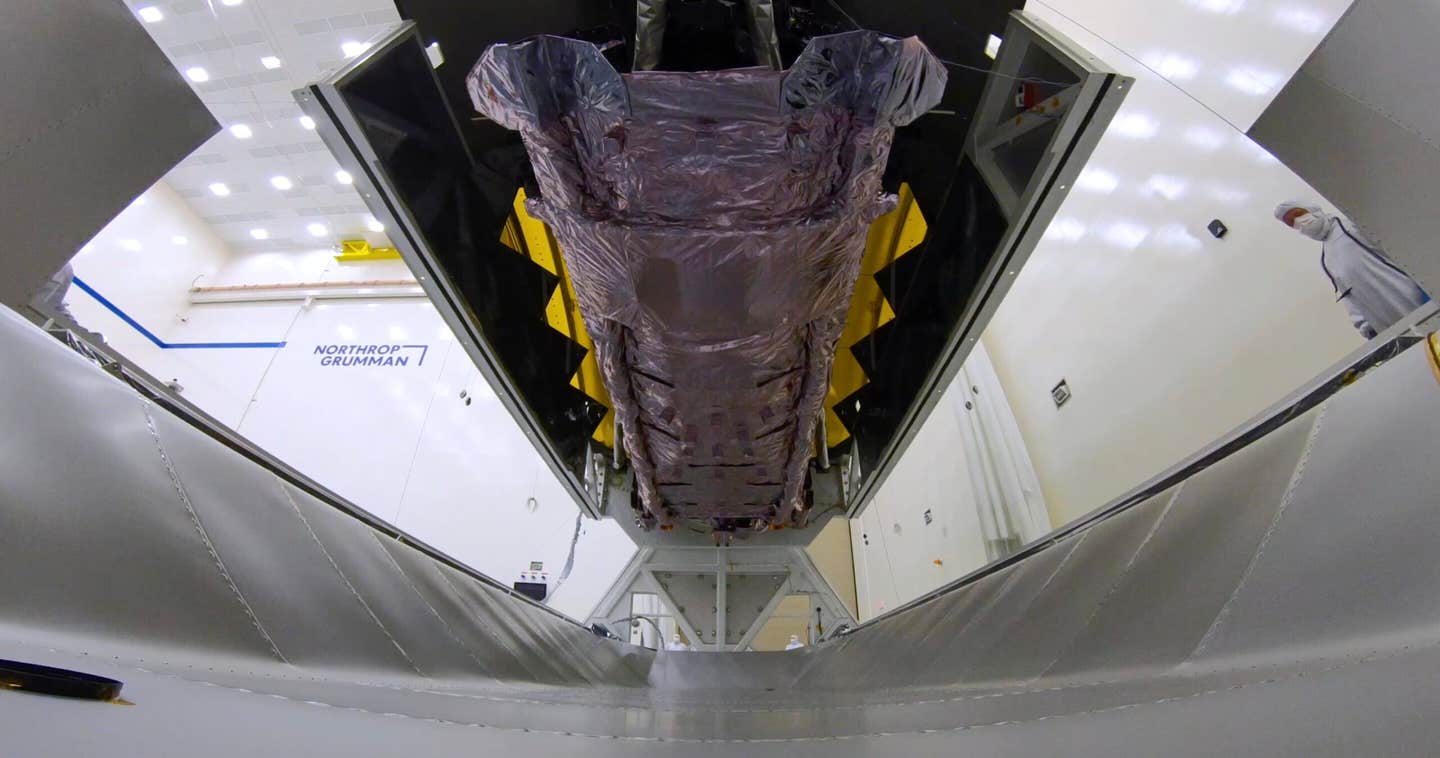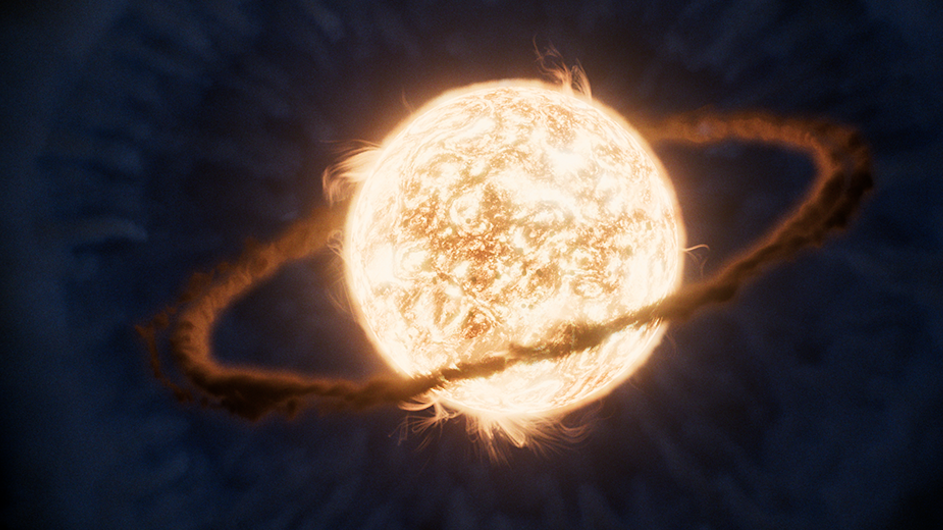How to ship the world’s largest space telescope 5,800 miles across the ocean
When NASA’s James Webb Space Telescope launches, it will undergo one of the most harrowing deployment processes any spacecraft has endured.

[Oct 18, 2021: NASA's Goddard Space Flight Center]
Ahead of its journey to its launch site, NASA’s James Webb Space Telescope is shown being lowered into its protective transport container in the Northrop Grumman clean room in Redondo Beach, California. (Credit: NASA/Northrop Grumman)
When NASA's James Webb Space Telescope launches, it will undergo one of the most harrowing deployment processes any spacecraft has ever endured. But before it even gets on top of its ride to space, Webb had to complete a final journey here on Earth: a roughly 5,800-mile (9,300-kilometer) voyage at sea.
Webb was shipped from California on Sept. 26, ultimately passing through the Panama Canal to reach the Port de Pariacabo—located on the Kourou River in French Guiana, on the northeastern coast of South America—on Oct. 12. Webb will now be driven to its launch site, Europe's Spaceport in Kourou, French Guiana, where it will begin two months of operational preparations before its scheduled Dec. 18 launch.
With the largest and most powerful space telescope ever built as cargo, nothing about this trip was normal.
A custom-made 'suitcase'
As a one-of-a-kind machine, Webb required a colossal, specially designed "suitcase" known as STTARS, short for Space Telescope Transporter for Air, Road and Sea. STTARS weighs about 168,000 pounds (76,000 kilograms). It is 18 feet (5.5 meters) high, 15 feet (4.6 meters) wide, and 110 feet (33.5 meters) long—about twice the length of a semi-trailer.
This custom container was outfitted for any extreme or unexpected conditions Webb could have encountered during travel. In designing, building, and testing STTARS, engineers carefully tested how to best protect the container from heavy rainfall and other environmental factors.
The Webb telescope's journey to space began with engineers packing the telescope into its protective transport container. The container was then moved from Northrop Grumman in Redondo Beach, California, to Seal Beach, California. Waiting at Seal Beach was the ship that would carry Webb to French Guiana. (Credit: NASA's Goddard Space Flight Center; Michael McClare (KBRwyle); Sophia Roberts (AIMM); Michael P. Menzel (AIMM); Tom Graves (Northrop Grumman); Larkin Carey (Ball Aerospace & Technologies))
Related Stories
Charting the course
Planning any trip is hard work. With Webb, added to that are the logistics of transporting an extremely large and incredibly sensitive space telescope across two oceans.
For Charlie Diaz, Webb's launch site operations manager at NASA's Goddard Space Flight Center in Greenbelt, Maryland, Webb's arrival in Kourou was the culmination of years of preparation: "There are just thousands of different things that go on behind the scenes: pulling permits, avoiding obstructions, selecting alternate routes…all kinds of nuances. I'm so proud of our team—we've been working at this now for a long time."
Webb's ship voyage will ultimately be bookended by two short drives, one in California and one in French Guiana. The first took Webb from Northrop Grumman's facilities in Redondo Beach, California, to its nearby port of departure at Naval Weapons Station Seal Beach. The second drive will bring Webb from the Port de Pariacabo to its launch site of Europe's Spaceport in Kourou.
Prior to these drives, Diaz's team conducted route surveys using satellite imagery to understand the variables at stake. They noted details down to potholes that needed to be filled or traffic lights that had to be lifted due to STTARS' height. In case of emergencies, the team also selected "safe havens," or places along the way where they could safely perform any necessary maintenance on the container.
Due to its sheer size and weight, STTARS traveled at a speed of only 5–10 miles per hour (8–16 kilometers per hour) on the road to maintain a smooth ride.
While STTARS has previously transported Webb components to other NASA or partner facilities primarily by air, the team chose to transport Webb by sea to Kourou due to the logistics of landing at the Cayenne Airport in French Guiana. The 40-mile (65-kilometer) route between the airport and the launch site features seven bridges that STTARS would have been too heavy to cross. In addition, the drive from the Port de Pariacabo to Webb's launch site is relatively short. In comparison, a drive from the Cayenne Airport to the launch site, factoring in STTARS' slow speeds and other constraints, would have taken about two days.
Compared to the turbulence of air travel and the forces experienced during landing, traveling by sea aboard the cargo transport ship MN Colibri was quite literally smooth sailing. MN Colibri was designed specifically to transport enormous rocket parts as well as sensitive payloads to Europe's Spaceport, also known as the Guiana Space Center. On average, the ship cruised at around 15 knots, or 17 miles per hour (27 kilometers per hour). Sandra Irish, lead structural engineer for Webb at Goddard, was in charge of making sure that no stresseswould "rock the boat" past an accepted level. Working with the shipping company and crew, she and her team ensured a ship route for STTARS that avoided rough waters.
After arriving at Seal Beach, California, Webb (inside of the protective transport container) was loaded into the MN Colibri. This process took several steps to accomplish. Once the telescope was loaded inside the cargo hold, the MN Colibri set sail for French Guiana. (Credit: NASA's Goddard Space Flight Center; Michael McClare (KBRwyle): Sophia Roberts (AIMM): Michael P. Menzel (AIMM); Victor Bradley)
Running a clean ship
As with other spacecraft, Webb must be kept clean while it is on Earth.
STTARS is essentially a mobile clean room. When Webb is on the move, STTARS maintains a low level of contaminants inside the container—no more than 100 airborne particles greater than or equal to 0.5 microns in size. For reference, half a micron is just one hundredth of the width of a human hair!
Webb's contamination control team employed several tried-and-true methods to clean both the outside and inside of the container and prepare it for receiving and carrying Webb. Members carefully inspected each screw, nut, and bolt for residual contaminants using ultraviolet light. Next, Webb was installed into STTARS while both were inside the Northrop Grumman clean room. This will seal in cleanliness until STTARS can be opened inside the receiving clean room at the launch site.
STTARS sailed to French Guiana inside MN Colibri's cavernous cargo hold, protected from weather and the sea, along with other equipment and supplies for launch preparations. A sophisticated heating, ventilation, and air-conditioning (HVAC) system built for STTARS monitored and controlled the humidity and temperature inside the container. Several accompanying trailers, loaded with dozens of pressurized bottles, provided a continuous supply of pristine, manufactured, dry air into the transporter's interior.
Neil Patel, Webb's transportation manager at Goddard, was one of five Webb team members who accompanied STTARS on its journey to ensure that Webb would remain in good condition: "Traveling through the Panama Canal with Webb was a once-in-a-lifetime experience, and a first-time activity for our team. It was very special to be bringing this observatory to the very last place it will be here on Earth," he said.
Having been transported by land, air, and now sea, the Webb telescope can already be considered a seasoned traveler. Soon, it will enter the final frontier it hasn't explored—the great expanse of space.
Like these kind of feel good stories? Get the Brighter Side of News' newsletter.
Tags: #New_Innovations, #Telescopes, #Transportation, #NASA, #Space, #Satellite, #The_Brighter_Side_of_News
Joseph Shavit
Head Science News Writer | Communicating Innovation & Discovery
Based in Los Angeles, Joseph Shavit is an accomplished science journalist, head science news writer and co-founder at The Brighter Side of News, where he translates cutting-edge discoveries into compelling stories for a broad audience. With a strong background spanning science, business, product management, media leadership, and entrepreneurship, Joseph brings a unique perspective to science communication. His expertise allows him to uncover the intersection of technological advancements and market potential, shedding light on how groundbreaking research evolves into transformative products and industries.



